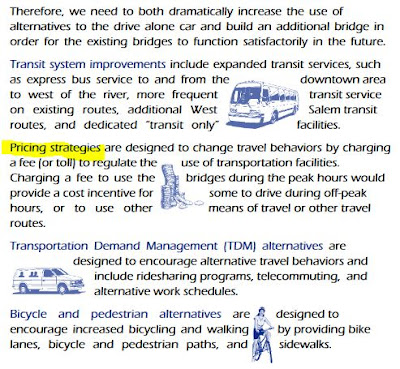 |
| Demand Management siloed from Public Works (In Salem, Cherriots does TDM, not the City) |
Present Incoherence in Policy
The specific recommendations for Individual marketing programs themselves are not of general interest here. But the final recommendation is more generally interesting and points to a major problem:
5. Integrate Demand Management into Local Transportation Departments' Vision, Goals, and ProcessesIf you are feeling very optimistic, that phrase in italics points to a tension between what we say we're going to do and what we actually fund and execute in our budgets.
In many places, TDM staff have little interaction with the professionals who manage street design, public transit, and parking policy, even though those departments play an enormous role in travel behavior. This puts TDM professionals in a position where they are charged with increasing use of sustainable transportation even as the broader policy environment makes this difficult (i.e. because transit is being cut, roads are being widened, or abundant free parking is provided). Often, the only funding is grant-based, making it difficult to undertake longer-term or more complex projects. To truly transform how people move in cities requires different aspects of the system working in concert: policy, planning, engineering, maintenance, monitoring; parking management, zoning and development code, street design, and growth plans; vehicle, freight, transit, shared mobility and active modes. All of these approaches must be aligned to bring about meaningful change. [italics added]
If you are feeling more pessimistic, that phrase indicates an outright structural contradiction and total incoherence in our approach to transportation and sustainability.
 |
| $10 million in widening for a near-highway interchange |
Moreover, by supplying more auto capacity, we create more future maintenance obligation and dig in on the "backlog of infrastructure maintenance and repairs" and exacerbate the "imbalance between revenues and expenditures."
We should stop doing projects that "increase reliance on the SOV" and add the "backlog of infrastructure maintenance."
Instead of working on the supply side, we should work on the demand side. We need to bring demand for drive-alone trips into better balance with our existing supply of road space. We should integrate all this into our general transportation planning. We have authority for that in our highest level policy document, the Comprehensive Plan.
 |
| The City could embrace these standards more passionately |
We have known for a long time what we needed to do.
Two generations ago back in 1980 we knew, and blew it off.
- A substantial increase in use of transit, carpooling, bicycling and walking, and perhaps the introduction of peak-hour shuttle systems between downtown Salem and West Salem.
- More attractors (employment, shopping, entertainment, schools) west of the river
 |
| Decongestion pricing recommended circa 1998 (Willamette River Crossing Capacity Study brochure, undated, via the Internet Archive, crawled in 2004) |
This neglectful approach was formalized in the Salem River Crossing.
The Salem River Crossing process has been structured to
allow the policy-makers/public to choose to make all or any of these investments in alternative modes without being tied to implementation of the needed highway improvements which are as yet unfunded...That is, measures related to the SRC to "decrease reliance on the SOV" are completely optional. Only the "highway improvements" for car travel are "needed." We do everything we can to minimize action for non-auto mobility and to maximize action for drive-alone mobility.
So a real shift in the budgetary and cultural paradigm is still necessary. While we have seen this shift at the level of very general rhetoric for many years, it has not translated into funded policy. We disconnect words from deeds.
We need to improve the way we talk about demand, not see demand as solely the popularity of drive-alone trips, but as the total demand for personal mobility. We also need to improve the way we talk about supply, to be more transparent that the only real solutions we have been talking about are supply-side, and that these supply-side solutions to increase auto capacity have real environmental costs, public health costs, and fiscal costs including the opportunity costs of other things we will not be able to do. And then we actually need to do things to adjust demand for drive-alone trips for a better balance with supply.






1 comment:
Today, Friday, October 6 at 4 p.m. in Public Works offices in City Hall, will be the first meeting of the Mayor's Committee on Transportation committee. I hope that the focus will include some discussion of the points you have raised here.
Post a Comment